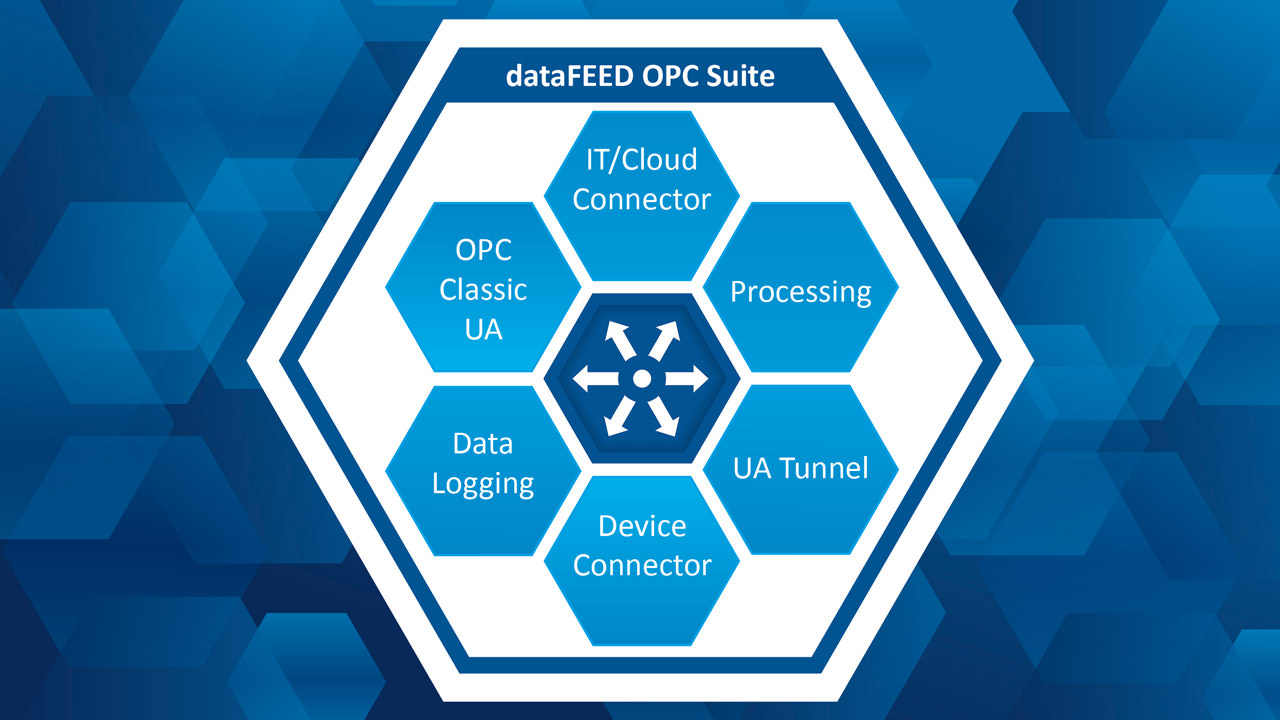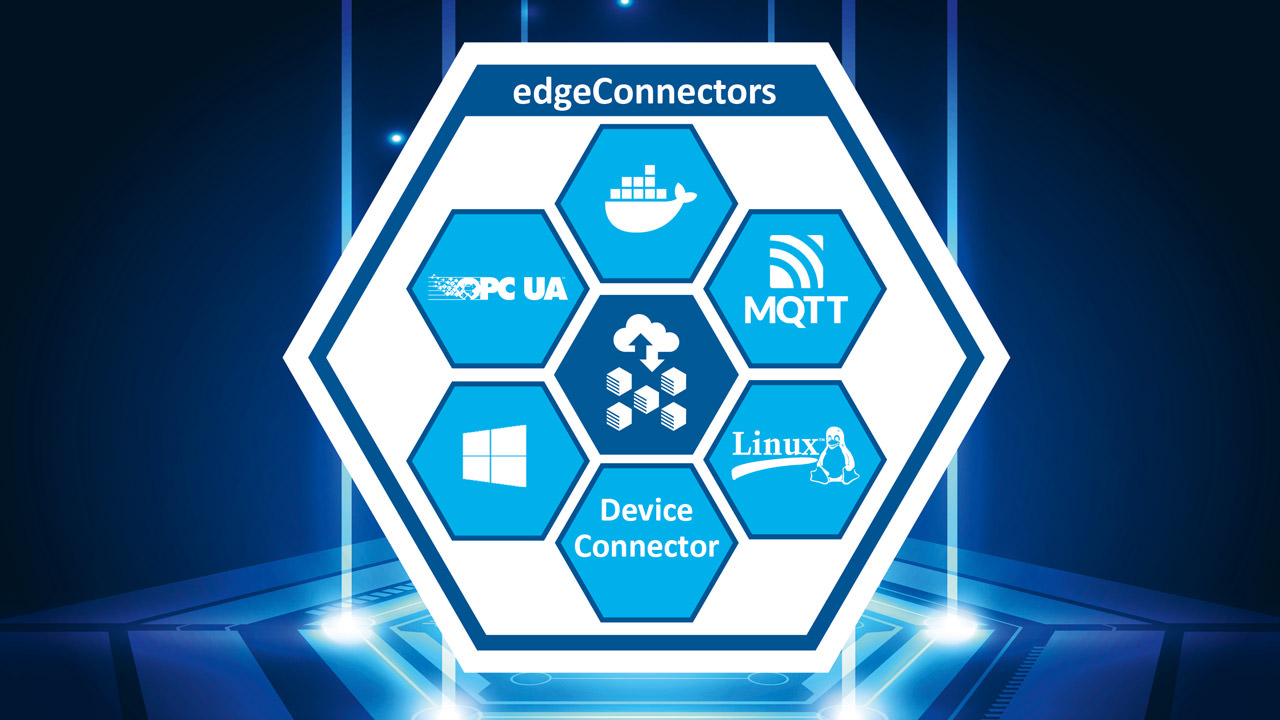TechnologyJanuary 23, 2025
Industry experts offer OPC UA solutions update

OPC UA solutions provide platform independence, secure data exchange, and scalability for industrial environments. Key advantages include standardized communication protocols and interoperable data models that simplify system integration. New cloud initiatives enhance the ability to aggregate and analyze data.
OPC UA TECHNOLOGY IS MAKING AN IMPACT in industrial automation applications as machine builders and end users leverage the technology to enable information exchange, achieve interoperability goals and integrate its security capabilities into a wide range of computer and networking technology solutions.
For this special report, the Industrial Ethernet Book reached out companies involved in developing technology solutions utilizing OPC UA technology. Here is what these industry experts had to say about the megatrends shaping the future of OPC UA for industrial networking, its influence on edge and cloud computing architectures and how the technology is advancing Industry 4.0 objectives. The future is bright as technology providers look to seamlessly integrate OPC UA with Ethernet-APL and TSN.

“Looking forward, we continue to engage industry experts from myriad domains to lend their know-how to the development and global cooperation on new information models. GenAI is helping here, reducing the time spent on this work. Harmonization of all these models will ensure consistency and avoid double standardization.” — Stefan Hoppe, President and Executive Director, OPC Foundation.
OPC UA security enhancements
Enables information exchange and facilitates applications like Digital Twins, AI and Metaverse.
According to Stefan Hoppe, President and Executive Director of the OPC Foundation, “OPC UA adoption is primarily being driven by the security enhancements that OPC UA brings to interoperable products. Combined with the exchange of standardized information, it provides a ready-to-use technology for information exchange throughout the automation pyramid and facilitates new applications like Digital Twins, AI and Metaverse, etc.”
OPC UA update
Hoppe outlined a series of developments that are shaping the direction of OPC UA.
- First of all, multiple security authorities throughout the world have analyzed and confirmed the OPC UA approach for improved encryption and authentication mechanisms that ensure robust protection against cyber threats.
- Secondly, OPC UA’s compatibility with IIoT platforms continues to support seamless connectivity, enabling predictive maintenance, remote monitoring, and analytics. This allows integrating OPC UA with edge devices, ensures real-time data processing, and localized control, enabling faster decision-making.
- In factory applications, it is critical to directly connect machines in horizontal architectures with one another. The OPC UA standardized Controller-to-Controller (C2C) communication, connecting all major PLC brands, is unique throughout the world, without any competition.
- Cloud scenarios provide centralized, semantic data storage, preserving the context of OPC UA-based information models, wherein data analytics can quickly and easily leverage standardized OPC UA data.
- Network infrastructure, like Ethernet-APL and TSN, are seamlessly integrated into OPC UA technology, thus, broadening additional fields of adoption.
“Looking forward, we continue to engage industry experts from myriad domains to lend their know-how to the development and global cooperation on new information models. GenAI is helping here, reducing the time spent on this work. Harmonization of all these models will ensure consistency and avoid double standardization,” Hoppe said.
“With the ecosystem of collaboration growing, likewise, adoption will grow in the future. Observing OPC UA, now embedded in vending machines and even large industrial kitchen equipment, we see OPC UA is growing beyond the core industrial automation market,” he added. “With end users frequently spreading the good news about OPC UA, they continue to accelerate adoption throughout their suppliers’ offerings.”
Technology distinctive
Hoppe said that OPC UA offers key technical advantages including the following:
- Interoperability: OPC UA provides platform-independent communication, enabling seamless integration of devices and systems across different vendors.
- Scalability: Suitable for even the smallest sensors, up to enterprise systems, OPC UA scales effortlessly in industrial environments.
- Security: Built-in encryption, authentication, and access control ensures secure data exchange. Very uniquely, it also covers security configuration, which is omitted by many other technologies.
- Data Modeling: Rich, standardized information modeling supports complex data structures and enhances system interoperability.
- Reliability: OPC UA ensures high reliability with redundancy and failover mechanisms for continuous operation.
- Internationality: OPC UA is an IEC standard with over 1010 members. The OPC Foundation brings to the table all major suppliers from both OT and IT, spanning all continents of the world.
Cloud initiative
He added that the OPC Foundation Cloud Initiative has three primary goals:
- Standardized interoperability: Accelerate interoperability of IT and cloud applications using OPC UA, e.g. data analytics using AI, industrial data spaces, digital product passports, industrial metaverse, as well as digital twin applications.
- Best practices: Create a cloud reference architecture to provide best practices to further increase standardized data sharing and cloud-optimized profiles for the OPC UA standard.
- Semantic Data Models in the Cloud: Preserve and Maintain OPC UA Information Models (Companion Specifications) within the cloud to utilize the context of data inside and across cloud services.
OPC UA certification also ensures compliance with the OPC UA specifications to provide high levels of interoperability and security, boosting user confidence and system reliability. The OPC Foundation Cloud Initiative will establish validation and certification for OPC UA Cloud Interoperability, including a new Protected Identity for OPC UA Cloud eXchange “UACXTM”, which makes it easy for end users to order a set of functionalities.
Applications focus
“Applications in factory automation require direct, horizontal communication. We will soon see the first products supporting the new OPC UA FX specifications by the Field Level Communications initiative,” Hoppe said. “End-customers are asking for OPC UA over MQTT communication in order to connect their IIoT applications and assets to cloud infrastructure. This is one communication solution common to all cloud suppliers.”
Hoppe said that several new OPC UA-based information models are focusing on energy activities, including electrolyzer assets. This market is rapidly growing as we humans strive to reduce the world’s CO2 footprint. First-release products are already available.
Analyzing all of the challenges across various domains, Hoppe said that they always see identical requirements for IoT and Enterprise Connectivity. In the end, it’s once again the same key factors, like interoperability, based on standardized data, which requires data modeling, a secure reliable connection between OT and IT, and (sometimes underestimated) a scalable solution (supporting diverse IoT ecosystems, from edge devices to enterprise-level systems). While other associations start to define new solutions for Digital Twins, OPC UA is enabling the creation and management of digital twins for improved asset management and process optimization.
Engineering challenges
“We have noticed that an increasingly connected world continues to run into engineering challenges of data complexity, like trying to simplify the handling of complex, multi-source data with robust information modeling and semantic frameworks. The OPC Foundation addresses this with Companion Specifications by expanding domain-specific standards for seamless implementation across industry verticals,” Hoppe said.
Additional challenges found within the cybersecurity threat landscape are being quickly solved with built-in encryption, authentication, and access control mechanisms native to OPC UA. The OPC Foundation continues its work to enhance the security standard, continuously updating security configuration by onboarding additional security concepts to meet evolving threats.
“Overall, we have significantly reduced complexity. As a young engineer, I started the development of an OPC UA server application that, in those days, took several months to complete. In contrast, today’s two-day hackathons – organized by domain specific groups, like the Laboratory and Analytical Device Standard (LADS) – propel developers, giving them a huge jumpstart on an OPC UA server, including a domain-specific information model, facilitating all on-board connectivity, all wrapped up by the end of the workshop,” Hoppe said.

“The latest OPC UA systems address key engineering challenges by standardizing communication across devices, eliminating the need for custom interfaces or middleware. ” — Dan White, Director of Technical Marketing for Opto 22.
OPC UA and MQTT Sparkplug
Direct connection eliminates middleware, simplifies system architectures, reduces costs, and improves data sharing.
“Modern edge devices like PLCs, energy monitors, and flexible I/O systems now include OPC UA servers onboard,” said Dan White, Director of Technical Marketing for Opto 22. “Running an OPC UA server directly on an edge device, with built-in support for SSL/TLS, allows standardized and secure communication directly to SCADA systems, MES platforms, and cloud applications.”
This direct connection eliminates the need for additional middleware, simplifying system architectures, reducing costs, and improving data sharing between devices. Some of these devices also support MQTT SparkplugB, making it easier, more efficient, and more secure to scale data flows from the edge to central servers or even the cloud.
White said that the next step in IIoT architecture is leveraging the symbiotic strengths of OPC UA and MQTT Sparkplug.
- OPC UA, built on a poll/response architecture, excels in managing diverse industrial protocols with a robust ecosystem of native drivers for industrial equipment already on the plant floor.
- MQTT Sparkplug’s publish/subscribe model enables efficient, real-time edge-originated communication. Together, they complement each other, combining robust data handling with scalable, event-driven messaging for a cohesive IIoT framework.
Technology benefits
OPC UA solutions provide several key technical advantages. Robust driver libraries, offered by servers like Ignition, KEPServerEX, and Matrikon, enable direct communication with a wide range of existing plant floor equipment. OPC UA cross-platform compatibility makes it easy to integrate and communicate across different systems and devices. Building on the trusted legacy of OPC, OPC UA enhances security, scalability, and flexibility while maintaining compatibility with existing systems.
“Cloud initiatives reduce the complexity of on-site systems by shifting data storage, analysis, and monitoring to the cloud. Traditionally, on-site systems required significant infrastructure, including servers, databases, and software, all of which needed regular maintenance, updates, and security measures. On-site setup often meant high costs, extensive IT support, and limited scalability,” White said.
“Using cloud platforms, edge devices can securely send data for real-time monitoring and analytics without needing local servers or complex hardware. Updates, backups, and scalability are handled by the cloud provider, reducing the burden on on-site teams. This shift allows organizations to focus on operations rather than IT management, enabling faster adoption of IIoT solutions,” he added.
Targeted applications
White said the newest OPC UA solutions are targeting individual machine builders who want to offer standardized connectivity directly from their equipment. In the Industrial Internet of Things (IIoT), the “things” are the machines on the plant floor, which historically lacked their own OPC UA servers.
Now, with OPC UA servers embedded directly in edge devices, these machines can communicate securely and efficiently without needing external middleware. This shift simplifies integration, reduces complexity, and provides faster, easier access to production data.
Existing legacy machines can also take advantage of inexpensive edge devices with onboard OPC UA servers. For under $1,000, you can take an existing machine, which was previously a black hole of data, and add an I/O device with an onboard OPC UA server, opening up access to uptime, downtime, and run rates that were previously recorded manually or not at all.
Addressing engineering challenges
“The latest OPC UA systems address key engineering challenges by standardizing communication across devices, eliminating the need for custom interfaces or middleware. They enhance data access by embedding OPC UA servers directly into edge devices, enabling even legacy machines to provide real-time production data without manual collection,” White said.
With built-in encryption and authentication, OPC UA ensures secure data exchange, addressing the security limitations of traditional industrial protocols. These systems also support scalability and interoperability, integrating seamlessly with complementary technologies like MQTT Sparkplug to balance poll/response and publish/subscribe architectures.
“Together, these advancements enable engineers to design robust, secure, and scalable IIoT systems that bridge the gap between legacy infrastructure and modern industrial demands,” White added.

“The PLC-based OPC UA Client enables our PLCnext Controls to act as OPC UA clients. This allows hierarchical communication structures with aggregation layers based on OPC UA.” — Dr. Andreas Würger, Technology Manager, PLC Next Technology, Phoenix Contact.
DaUM and PLC-based OPC UA client
Combines data modeling, security and communication in a number of critical areas.
According to Dr. Andreas Würger, Technology Manager – Business Area Industry Management and Automation for PLC Next Technology, “the most important solutions are our device and update management application (DaUM) and our PLC-based OPC UA client.”
“DaUM is an application that can be run on both Windows computers and Edge devices and enables the updating of software on devices via DI Standard (OPC UA specification Part 100). DaUM also contains a Global Discovery Server that can be used to manage and distribute device certificates,” Würger said.
“The PLC-based OPC UA Client enables our PLCnext Controls to act as OPC UA clients. This allows hierarchical communication structures with aggregation layers based on OPC UA. Another highly important aspect is the ability to load and map external information models in the OPC UA server of the PLCnext controllers. This enables that all information models defined in the Companion Specifications of the OPC Foundation can be adapted,” he said.
OPC UA solutions
Würger said that OPC UA combines the aspects of data modeling, security and communication in a number of critical areas:
- Data modeling: The modeling rules can also be used to create complex information models. There are also various companion standards that define model elements for specific assets or technologies.
- Security: OPC UA has built-in security mechanisms, such as encrypted data transfer and role-based access management.
- Communication: Various communication paradigms, such as client/server or pub/sub, are available for the transfer of data.
This combination makes OPC UA one of the most important technologies for the future of automation. We also have these three aspects in mind when using OPC UA as a technology, as the solutions mentioned above show.
Würger said that an important aspect for the future will be OPC UA PubSub via MQTT. He views this as the final piece of the puzzle towards end-to-end OPC UA communication from the device to the cloud through any intermediate levels without breaks in communication technology, security architecture and data modeling.
DaUM enables the updating of software on devices and certificate management via GDS. DaUM’s contribution to IoT and enterprise connectivity is that all devices and their software and certificates are monitored and managed at one central location.
“The PLC-based OPC UA client enables the PLC as a client to establish connections to subordinate servers. As already mentioned above, this allows hierarchical communication structures with aggregation layers to be set up in which a PLC coordinates other PLCs as the master controller,” Würger said. “But PLC-based OPC UA Client also takes into account the fact that more and more complex devices have their own OPC UA servers, which can then be connected to the PLCnext controller via the client.”
Engineering challenges
DaUM addresses the challenge of keeping the firmware and security of devices up to date.
“However, OPC UA is such an important technology, a general engineering challenge that we want to address with our solutions is that the complexity of OPC UA does not exactly make it easy for new users to get started with the technology,” Würger said.
For example, a user who only wants to implement a specific use case is quickly confronted with a number of standards, functions and models that are difficult to understand. This is precisely the scenario that Phoenix Contact wants to prevent with its OPC UA portfolio in the context of the PLCnext ecosystem.
He added that, to this end, they rely on a variety of simple and complex application examples for the various communication scenarios, helpful open source software tools and meaningful and intuitive documentation. For the PLC-based OPC UA client, for example, there is a free available test license and simple and complex project examples for free download.
OPC UA automation solutions
Driven by technology to enable edge and cloud connectivity using standardized communication.
“The adoption of OPC UA in automation and control is driven by key technologies such as edge computing, cloud connectivity, and standardized communication,” said Andreas Röck, Head of Product Management Nuremberg at Softing Industrial Automation GmbH.
Softing Industrial Automation’s OPC UA product portfolio, including solutions like dataFEED OPC Suite, encompass these technologies and provides seamless data integration from shop floor to cloud, enabling interoperability between devices from different manufacturers. Technologies such as PubSub over MQTT and Time-Sensitive Networking (TSN) are accelerating the adoption of OPC UA by supporting real-time communication and enhancing data flow efficiency.”

The Secure Integration Server from Softing addresses smart data management by leveraging OPC UA to aggregate and secure data exchange between operational technology (OT) and IT systems.
“The next steps in OPC UA adoption involve broader implementation of OPC UA over TSN for deterministic control and increased certification initiatives to ensure device interoperability,” Röck said. “Expansion into semantics-based data modeling is also key, as it enhances machine-readable contextualization, supporting applications like predictive maintenance and digital twins.”
Standardized protocols
Röck said that OPC UA solutions provide platform independence, secure data exchange, and scalability for industrial environments. Key technical advantages include standardized communication protocols and interoperable data models that simplify system integration.
These advantages are met by Softing’s OPC UA offerings, such as edgeConnector solutions, which support seamless, secure data transfers between PLCs and enterprise IT systems via OPC UA and MQTT protocols.
New cloud initiatives enhance the ability to aggregate and analyze operational data from multiple sites, fostering global system optimization. Certification programs, like those driven by the OPC Foundation, ensure that OPC UA-enabled products adhere to robust standards for interoperability and cybersecurity. This certification increases trust, reduces integration risks, and enables faster deployment of cloud-based IoT solutions.
Applications
Röck said that modern OPC UA solutions target smart factories, energy management, predictive maintenance, and supply chain optimization. The Secure Integration Server from Softing, in particular, addresses smart data management by leveraging OPC UA to aggregate and secure data exchange between operational technology (OT) and IT systems, meeting industry compliance requirements.

Docker-based OPC UA software solutions run as containers and offer a flexible and scalable way to use OPC UA functionalities.
“In IoT ecosystems, OPC UA supports seamless connectivity between sensors, controllers, and cloud applications, facilitating real-time monitoring and decision-making. OPC UA communication also contributes to edge-to-cloud integration, which is essential for scaling IoT infrastructures and achieving comprehensive digitalization,” Röck said.
The latest OPC UA systems also address engineering challenges such as data silos, legacy system integration, and cybersecurity concerns.
“To meet evolving industry demands, specifications for OPC UA are enhanced with features like TSN for deterministic communication and information modeling for richer context representation,” Röck said. “The development of OPC UA FX (Field eXchange) further supports real-time control and interoperability in factory environments, addressing the need for vendor-agnostic industrial control.”
Röck said that Softing’s offerings align with these advancements, providing robust solutions for seamless, secure communication across diverse architectures in support of comprehensive Industry 4.0 strategies.
OPC UA information model
Visibility into manufacturing operations with a heterogeneous suite of software applications
According to Paul Brooks, senior manager, open architecture management at Rockwell Automation, the common thread in the advancements of OPC UA technology and adoption “is visibility into manufacturing operations with a heterogeneous suite of software applications needing to look at information from common sources to provide that information.”
“It may be a machine builder monitoring the causes of downtime on their fleet of machines, or a manufacturer benchmarking energy consumption across lines and plants,” Brooks said. “OPC UA became the de-facto standard for interoperable in-plant information gathering and the technology’s next task is to establish the same position for plant to cloud information gathering.”
Importance of information model
Brooks said that the heart of OPC UA is the information model, allowing endpoints to be self-describing, both of their own model and the context in which they are operating. This is complemented by the companion specification philosophy which allows applications to define the semantics and structure of the information that they gather. In a heterogenous environment, ensuring that both producer and consumer of the data interpret it the same way is invaluable!
“But OPC UA’s biggest strength is non-technical; it is the breadth of adoption and the size of ecosystem,” Brooks said. “The cloud initiative’s biggest strength is that all the relevant hyper scalers are participating, and its success will be determined by their adoption more than specific technical details. To that end, critical mass is also needed for certification to have value – a certified server connected to an uncertified client offers no guarantee of interoperability. Certification must have broad adoption to be meaningful.”
He added that the OPC Foundation has two primary initiatives: Field eXchange and Cloud eXchange. While technically very different, they serve a common purpose – driving available information sources as close to the manufactured product as possible (FX) and disseminating that information as wide as possible (CX). The combined outcome is that the number of “things” that can participate in an IoT solution grow, as do the number of IoT applications that can be used by enterprises.
Addressing challenges
Brooks said that industrial users want the same amount of flexibility in their professional lives as they do in their personal lives. It is easy to wear a fitness tracker on your wrist, connect your smart bathroom scale to the internet, and bring them together with your meal planning app, which feeds your local store’s shopping list app. All from different vendors with different cloud storage but with a combined outcome of controlled weight loss.
“OPC UA needs to evolve to deliver that level of flexibility and interoperability to the IIoT without the user ever needing to know anything about the underlying technology or what needed to be done to deliver it,” Brooks said.

“Industrial IoT (IIoT) is currently a main driver for the use of OPC UA, especially for OPC UAFX, often described in this context as the connectivity from the sensor to the cloud” — Maik Seewald, Member of IEC and ISA99 industrial security workgroups and Senior Technical Lead, Industrial IoT at Cisco.
Impact of OPC UA FX and TSN
IIoT applications is a main driver using the OPC UA architectural framework.
New technology solutions including OPC UA FX, TSN and the Industrial Internet of Things (IIoT) are driving the adoption of OPC UA automation, control and networking solutions.
“Industrial IoT (IIoT) is currently a main driver for the use of OPC UA, especially for OPC UA FX, often described in this context as the connectivity from the sensor to the cloud,” Maik Seewald, Member of IEC and ISA99 industrial security workgroups and Senior Technical Lead, Industrial IoT at Cisco told the Industrial Ethernet Book recently.
Seewald said that OPC UA FX introduces the publish/subscribe pattern in addition to the existing client/server within the OPC UA architectural framework. TSN as the underlying networking technology enables data exchange with guaranteed latency and high availability.
“In the next step, the capabilities of OPC UA FX will provide the opportunity to replace or extend existing M2M protocols to establish connectivity between devices in industrial automation, everything built on open standard technologies,” Seewald said. “This pertains to controller to controller as well as to controller to device communication. Ultimately, OPC UA FX supports the architectural approach of virtualized control – moving the control logic (e.g.: PLC) into the cloud with benefits regarding business process integration, maintainability and agility of the entire automation solution.”
Multi-platform framework
Seewald said that the OPC UA architecture encompasses a multi-platform framework comprising information model, communication protocols and built-in security. It is designed by taking advantage of a layered model which is extensible and allows the integration of new technologies, for instance wireless such as 5G or Wi-Fi.
OPC UA solutions enable network convergence, allowing services and protocols with different criticality and quality attributes on the same wire. As an example, the use of OPC UA FX in industrial automation supports a network design, where mission critical traffic (automation and control) co-exist with services such as audio and video on the same physical infrastructure without impacting stringent latency and availability requirements.
The use of OPC UA in the context of cloud deployments allows secure end-to-end communication in order to connect devices in the field (process) or on the factory floor (manufacturing) to highly configurable, extensible and business-centric applications, creating real Cyber-Physical Systems in industrial automation.
Certification initiatives such as the TSN Industrial Automation Conformance Collaboration (TIACC) are established to foster interoperability in the open and multi-vendor environment of OPC UA FX when using the TSN-profile for Industrial Automation (IEEE/IEC 60802) as part of the communication stack.
They are important to assure compliance with the underlying standards in order to enable a multi-vendor ecosystem.
Leveraging the IIoT
“The newest OPC UA solutions are evolving in the area of Industrial IoT (IIoT), connecting devices to applications running in the cloud,” Seewald said. “This typically starts with simple use cases such acquisition of sensor data from the processes, and might lead to highly sophisticated solutions of virtualized control. Because of its multi-platform and multi-vendor approach, OPC UA allows the creation of secure end-to-end connectivity crossing layers of the automation pyramid (field, control, execution, ERP) and even allowing integration with external systems and processes.”
He added that complex solutions built with OPC UA in the area of industrial or process automation require comprehensive planning and configuration, especially if determinism and network convergence are the objectives. Engineering challenges are often related to the provisioning of precise configuration data, especially in setups where multiple departments are involved. The OPC UA framework already contains the means to solve those complex tasks by providing an extensible information model and allowing open standard based network configuration using NETCONF/YANG.

“The main challenge of data integration is being continuously addressed with a growing offering of OPC UA functionality and implementations.” — Konstantin Selnack, Product Owner – Industrial Connectivity Products at Siemens AG.
Interoperability standards
Seamless integration makes OPC UA a universal language for industrial automation.
Konstantin Selnack, Product Owner – Industrial Connectivity Products at Siemens AG said that “the adoption of OPC UA in automation is driven, on the one hand, by the increasing need for data acquisition and exchange in an open, interoperable manner across Operational Technology (OT) and Information Technology (IT), which is critical for Industry 4.0 implementations.”
“But also, the standard itself, with its compelling capabilities for highly sophisticated communication, is driving the adoption. Continuously providing new features and involving more industrial domains is a convincing factor to apply OPC UA,” Selnack said.
“In the end, these developments come together in the products and solutions of the technology providers. Today, OPC UA is not only found in controllers, but also in RFID readers, network management software and even power supplies. At the same time, these products are being expanded with additional OPC UA capabilities, he added.
Seamless integration
Selnack said that, first and foremost, OPC UA is the interoperability standard for industrial communication. It allows for seamless integration of different systems and devices, making it a universal language in industrial automation.
In addition, the information modeling of OPC UA provides the “grammar” which allows industrial domains to build their own semantics within Companion Specifications. The AutoID companion specification for instances, provides a standardized information model for RFID readers, allowing to seamlessly integrate a RFID reader independent from the vendor specifics.
In a nutshell, OPC UA allows for better data management and analysis, leading to process optimization, predictive maintenance, and other Industry 4.0 use cases.
“All this is based on a highly sophisticated communication standard. It uses Ethernet and therefore can be adapted to any network configuration, making it a versatile solution for connecting various systems of different scales within the industrial domain,” Selnack said. “But it also provides a robust security architecture, which is essential for industrial communication. OPC UA includes features like authentication, authorization, encryption, and data integrity checks.”
Integrating IT and OT
According to Selnack, the core concept of integrating OT with IT remains the primary focus, and OPC UA continues to expand its functionalities to support this integration. He said that a significant development is OPC UA PubSub, which incorporates MQTT to facilitate the connection with cloud-based applications. By utilizing OPC UA PubSub with MQTT, these solutions offer a direct data flow to cloud and IoT platforms, facilitating advanced data analysis and better decision-making, helping enterprises to achieve greater operational efficiency or reduce downtimes and maintenance cost.
But also managing OT devices with OPC UA capabilities is getting more attention. The addition of e.g., standardized REST-interfaces, certificate management via the Global Discovery Service or device updates via OPC UA shows that the adoption of IT technology is of big interest.
Another area of interest is interoperability at the field level. Here, OPC UA FX has been introduced, providing an open communication standard for connection establishment and data exchange of PLCs. UA FX is therefore bringing OPC UA benefits like interoperability or built-in security to the controller level.
Seamless integration
“OPC UA FX is a response to the need for seamless integration between diverse controller platforms, which traditionally has been a complex and painful process for line integrators and end-users. UA FX helps to reduce the integration and maintenance cost in these setups by providing a standardized information model and methods to interconnect controllers with each other,” Selnack said. “It also supports the offline engineering of systems – a UA FX machine description will provide the required machine data which has to be exchanged, allowing to do the engineering upfront.”
Another challenge is the realization of the increasing security requirements in operational environments. Certificate management for instance is a huge challenge and requires today a high effort. OPC UA Part 12, Discovery and Global Services, introduces the Global Discovery Server, which provides a framework to roll out and maintain certificates for OPC UA devices, providing a solution to this issue.
“Overall, the main challenge of data integration is being continuously addressed with a growing offering of OPC UA functionality and implementations,” Selnack said. “Thus, the evolution of OPC UA reflects the ongoing needs of the industry and provides answers to today’s and tomorrow’s challenges.”


